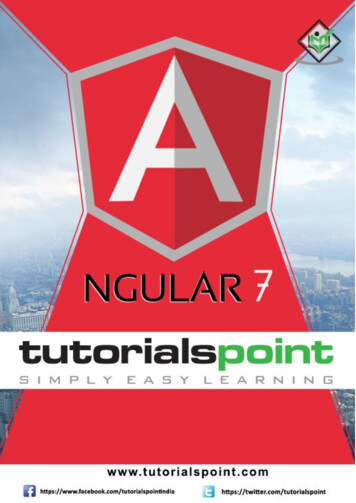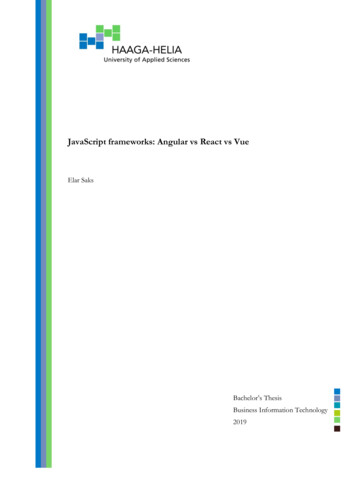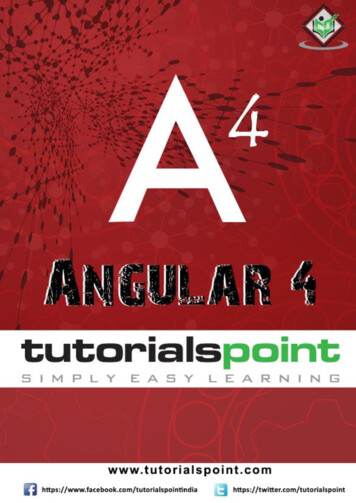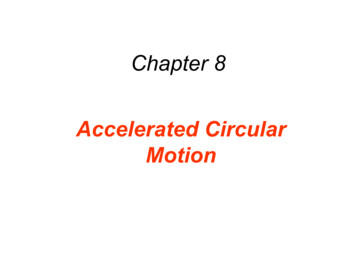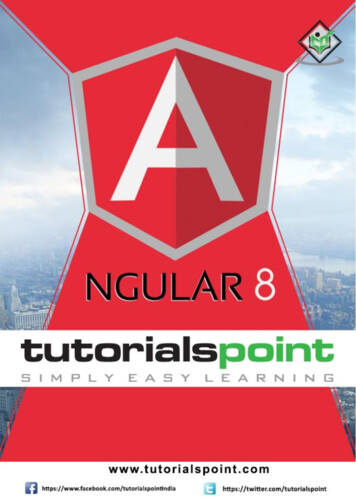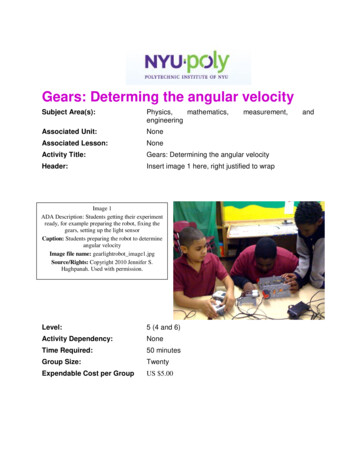
Transcription
Gears: Determing the angular velocitySubject Area(s):Physics,mathematics,engineeringAssociated Unit:NoneAssociated Lesson:NoneActivity Title:Gears: Determining the angular velocityHeader:Insert image 1 here, right justified to wrapImage 1ADA Description: Students getting their experimentready, for example preparing the robot, fixing thegears, setting up the light sensorCaption: Students preparing the robot to determineangular velocityImage file name: gearlightrobot image1.jpgSource/Rights: Copyright 2010 Jennifer S.Haghpanah. Used with permission.Level:5 (4 and 6)Activity Dependency:NoneTime Required:50 minutesGroup Size:TwentyExpendable Cost per GroupUS 5.00measurement,and
Insert Image 2 here, centeredImage 2ADA Description: One of the robot designs that will be used for determining angularvelocity of gearsCaption: Gear robot with light sensorImage file name: Gearlightrobot image2.jpgSource/Rights: Copyright 2010 Jennifer S. Haghpanah. Used with permission.Insert Image3 here, centeredImage 3ADA Description: Students setting up the data logging program in conjunction withthe light sensorCaption: Gear experimental set upImage file name: gearlightrobot image3.jpgSource/Rights: Copyright 2010 Jennifer S. Haghpanah. Used with permission.
SummaryStudents will work as engineers and learn to conduct controlled experiments bychanging one experimental variable at a time and study its effect on the outcome of theexperiment. Specifically, they will conduct experiments to determine the angular velocityfor a gear train with varying gear ratios and lengths. First, the students will assemble arobot with various size gears in a gear train. Second, they will design a program in NXTMindStorm that will cause the motor to rotate all the gears in the gear train. Third,students will use MindStorms Data Logging Program to setup their experiment with thelight sensors. Fourth, they will run the program with the motor and the light sensor at thesame time. Fifth, they will analyze the plot from MindStorms Data Logging Program anddetermine the angular velocity with a physics based formula. Sixth, they will manipulatethe gear train with different gears and different lengths. Finally, students will analyze allthese factors and figure out which manipulation has a higher angular velocity.Engineering ConnectionStudents will learn to design a setup for engineering experimentation. Specifically, theywill design their own robot and write their own programs for the robot and determine theangular velocity. Moreover, by changing the design of the robot they will figure out whatdesign features will help increase the angular velocity. They will change gears andnumber of gears to optimize angular velocity.Engineering CategoryRelates physics concepts to engineeringKeywordsGear, gear train, angular velocity, robotEducational Standards New York State Standards– New York science: 4.4, 4.5– New York math: 3.1, 3.2, 3.3, 3.5– New York Technology 5.1, 5.3, 5.4Pre-Requisite Knowledge: Division, multiplication, and basic concept of functionLearning ObjectivesAfter this activity, students will be able to: Design a Lego robot with a gear train Program a robot with NXT MindStorms software Design a gear train with two different types of gears with a specified number of gears
Open up MinStorms Data logging program with light sensor and record the amountof times the red light is sensed with the light sensorInsert Image 4 here, centeredImage 4ADA Description: Result observed from the Data logging program from NXTMindstormsCaption: Mindstorms Data logging experimental resultImage file name: gearlightrobot image4.jpgSource/Rights: Copyright 2010 Jennifer S. Haghpanah. Used with permission. Calculate the angular velocity of the rotating gears using the light sensor to detectthe rotation of the wheel the with the formula below:Angular Velocity (radians/sec) 2*Pi(radians)/Period (sec)(Eq. 3)One period is the amount of time it takes for the wheel to do one full rotation. This isdetermined using the NXT MindStorms Data logging Program as outlined in theinstructions. Change one variable at a time and examine its effect on the angular velocity
Materials ListEach group needs: Lego NXT Kit Two NXT bricks Calculator Ruler Two pieces of electrical tape (not including black)To share with the entire class: Computer with NXT MindStorms programming software Computer with NXT MindStorms Data logging ProgramIntroduction / MotivationThe term speed is often used to describe how fast an object can travel. Here we will tryto determine how fast a set of gears turn are on a gear train. To do so, we will use alight sensor with the MindStorms Data logging program. Then, we will adjust the typesof gears and the length of the gear train and determine the angular velocity for each ofthe different types of gear trains. Students will determine the optimal gear train basedon the fastest angular velocity achieved.Students love watching cars moving fast. Gears are important for the movement ofvehicles. In this experiment, they will learn about all the math and science that goesinto the angular velocity of a gear train. They will make their own robotic creations andtheir own program that will cause a robot gear train to spin fast. Students will also learnthe importance of each variable in the outcome of the experiment. They will change onevariable at a time and determine which variable will make the gear train have thehighest angular d (sec)The length of time to complete one cycleGearA rotating machine with cut teethGear TrainA set of gears that are able to transfer rotational motionCircumference The distance around a circle.(cm)DegreesThe unit of measure for a given angleRadiansThe unit of measure for a given angle equal to 57.296 degreesLinearThe distance traveled per unit timeVelocity (cm/Sec)Radius (cm)The length of a straight line segment from the center of the circle to
Diameter (cm)AngularVelocity(radians/ sec)the circumference of the circle.The length of a line segment passing through the center of a circle andintersecting both sides of the circle.Rate of change of angle with time.ProcedureBefore the Activity1. Have the students design their own robot that will be used to calculate angularvelocity.2. Have the students program the robot and show that they can rotate a set of gears ina gear train.3. Go over MindStorms Data logging program and show how the light sensor works inthe program. Refer to the program4. Teach the students circumference, units for circumference, velocity, and angularvelocity. Go over the physics based formulas with them.5. Ask students what they think will happen to the angular velocity when they changethe gear length and gear ratio in the gear train.6. Ask students to start with two different gears (i.e. a big and a small) in the gear trainand then they can try other gear ratios.7. Divide students into groups and assign each group member a task.8. Make sure each student has the handout for the activity.With the Students1. Show the students various gears and have them make observations.2. Have the students design their gear train robot with two gears. Next, have themcreate their program using the Lego MindStorms software. They should look at alltwo-gear systems with different gear ratios first.3. Have the students work with the light sensor in MindStorms Data logging program.The light sensor takes in ambient light and is able to distinguish between dark andlight colors. It can simply measure the intensity of the different lights and can beprogrammed to react to a particular intensity. The light sensor will detect timeinstances when the strip of white or orange tape on the wheel comes into view of thesensor. The data logging software will show those instances on a time plot as spikesin the detected light intensity.4. Take the gear train and connect it to a motor with a taped wheel at the end shown inimage 2.5. Measure the period for each type of gear train using the MindStorms Data loggingprogram. (Be sure to look at Image 4 for reference).6. Once all data has been obtained for two-gear systems, begin to change thevariables, one at a time.
7. First, change the number of gears in the gear train, and determine the angularvelocity using the Lego MindStorms Data logging program and the physics basedformulas.8. Next, change the gear ratio for the length of interest and determine the angularvelocity using the Lego MindStorms Data logging program and the physics basedformulas.9. Have the students discuss what they have learned from the experiment and havethem fill out their conclusions in the lab report.AttachmentsAngular Velocity Teach Engineering.docAngular Velocity Teach Engineering handout.docgearlightrobot image1.jpggearlightrobot image2.jpggearlightrobot image3.jpggearlightrobot image4.jpgSafety Issues Be careful not to poke fingers into gears when MindStorms program are runningTroubleshooting TipsMake sure that the periods are accurately determined in the MindStorms Data loggingprogramInvestigating QuestionsWhich gear train had the highest angular velocity for the two-gear system? Why?What happened to the angular velocity when the length of the gear train was increased?For a four gear train, what gear ratios would be best to use to obtain a system with ahigh angular velocity?AssessmentPre-Activity AssessmentGuessing game: Ask them to predict which set of gears in the two-gear train system willhave the highest angular velocity.Activity Embedded AssessmentDesign a robot: Tell the students to make a two-gear system gear train. Ask them ifthey can show you how the gear train works?Post-Activity AssessmentTuning the equation: Challenge the students and ask them to change the gears in thegear train and the length of the gear train. Ask them what gear train is optimal for a highangular velocity.
Activity Scaling For lower grades: None For upper grades:Calculate the linear velocity of the wheel’s outer surface. (velocity of a point on thecircumference of the wheel). Use the following formula: linearvelocity(cm/sec) angular velocity(radians/sec) * radius(cm). Do this for various gearconfigurations.Additional Multimedia SupportNoneReferencesHewitt, Paul. Conceptual Physics. New Jersey: Prentice Hall, 2002.Zitzewitz, Paul. Physics Principles and Problems. Ohio: McGraw-Hill, 2002.OtherNoneRedirect URLhttp://gk12.poly.edu/amps/OwnersJennifer S. HaghpanahContributorsJennifer S. Haghpanah, Leonarda Huertas, Jasmin Mejias, Mihai PrunaCopyrightCopyright 2010 by Polytechnic Institute of NYU. The development of this activity wassupported by Project AMPS under a GK-12 Fellows grant 0741714 from the NationalScience Foundation.Version: January 2010
robot with various size gears in a gear train. Second, they will design a program in NXT MindStorm that will cause the motor to rotate all the gears in the gear train. Third, students will use MindStorms Data Logging Program to setup their experiment with the light sensors. Fourth, they will run the program with the motor and the light sensor .
